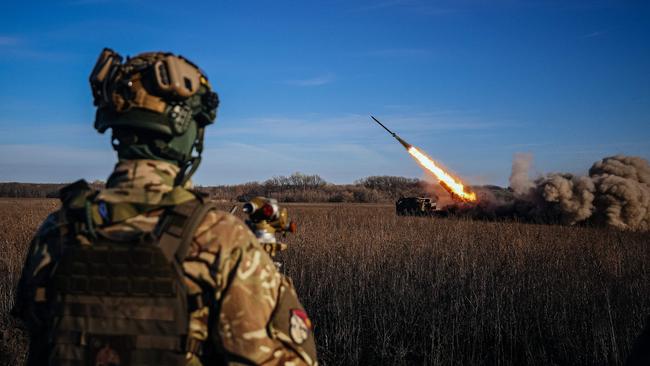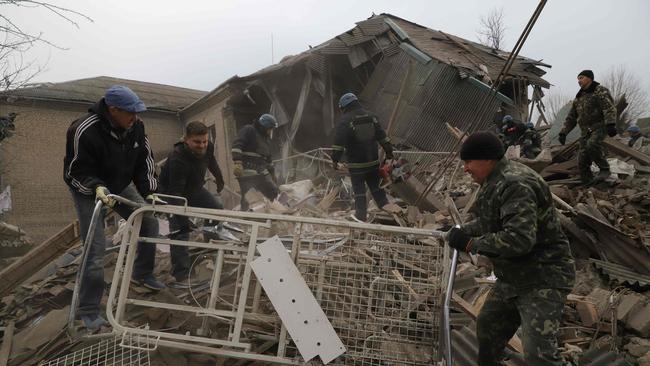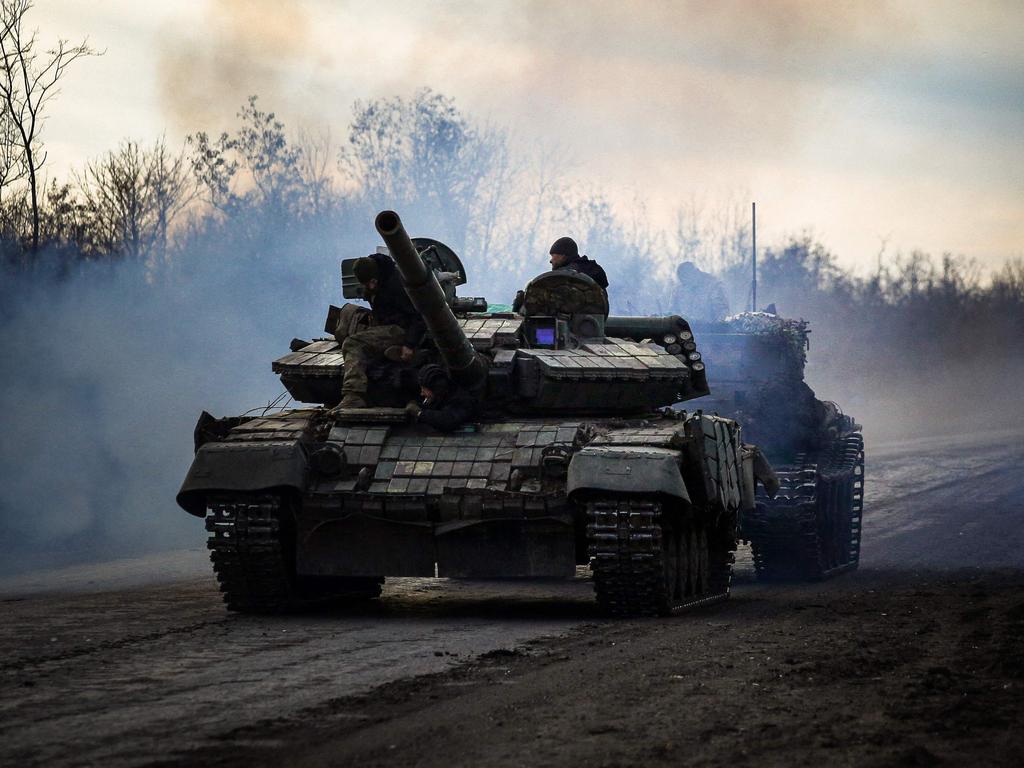US altered Himars rocket launchers to keep Ukraine from firing missiles into Russia
The Biden administration secretly modified rocket launchers it gave to Ukraine to prevent its army further inflaming the war.

The U.S. secretly modified the advanced Himars rocket launchers it gave Ukraine so they can’t be used to fire long-range missiles into Russia, U.S. officials said, a precaution the Biden administration says is necessary to reduce the risk of a wider war with Moscow.
The U.S. since June has supplied Ukrainian forces with 20 High Mobility Artillery Rocket System launchers, or Himars, and a large inventory of satellite-guided rockets with a range of almost 50 miles. Those rockets, known as the Guided Multiple Launch Rocket System, or GMLRS, have been used to strike Russian ammunition depots, logistics supplies and command centers on Ukrainian territory.
But the Himars launchers have a unique feature intended to prevent them from becoming even more potent battlefield systems. U.S. officials say the Pentagon has modified the launchers so they can’t fire long-range missiles, including the U.S.’s Army Tactical Missile System rockets, or ATACMS, which have a range of nearly 200 miles.

The previously undisclosed modifications show the lengths the Biden administration has gone to balance its support for Ukraine’s forces against the risk of escalation with Moscow. They also reflect apprehensions among administration officials that their Ukrainian partner might stop keeping its promise not to strike Russian territory with U.S.-provided weapons.
The U.S. has refrained from supplying Ukraine with long-range ATACMS missiles. But the modifications ensure that Ukraine couldn’t use the Himars launchers the U.S. has provided to fire ATACMS missiles if Kyiv were to acquire them from other sources, such as foreign nations that have purchased the weapons from the U.S. Nor could Ukraine use those launchers to fire other types of longer-range missiles if Kyiv somehow managed to produce or acquire them, officials say.
The Pentagon declined to comment on the modifications, which U.S. officials said involve their hardware and software.
“Due to operational security considerations, we do not comment publicly on the configuration of systems provided to allies and partners,” said Air Force Brig. Gen. Patrick Ryder, the Pentagon spokesman. “The United States remains committed to providing Ukraine the capabilities it needs to counter Russian aggression.” The Ukrainian military declined to comment.
The Biden administration has repeatedly said that decisions about a possible diplomatic resolution with Russia are up to Kyiv, and that Washington’s goal is to put Ukraine in the strongest possible position should peace talks ever unfold. But military support the U.S. and its allies have provided Kyiv has shaped what Ukraine is able to accomplish on the battlefield.
Since Russia massed forces to invade Ukraine in February, the U.S. has gradually expanded the types of weapons it has been willing to provide to Kyiv beyond the shoulder-fired Javelin antitank missiles Ukraine first received during the Trump administration.
After months of internal discussion about how to provide Stinger antiaircraft missiles that didn’t contain classified equipment, the first Stingers from U.S. stocks arrived in Ukraine in late February shortly after the Russian invasion was under way. U.S.-made Stingers from Baltic nations began to arrive in Ukraine early that month.
By April, M777 howitzers were being shipped to Ukraine. In May, Defense Secretary Lloyd Austin said that Denmark would provide U.S.-made Harpoon antiship missiles and a shore-based launcher to fire them.
Later that month, U.S. officials said that they would provide wheeled Himars. Those launchers, officials said, would be used to fire the GMLRS, which have roughly twice the range of the howitzers.
To guard against the risk of escalation, the U.S. secured a commitment from President Volodymyr Zelensky that the launchers wouldn’t be used to strike targets on Russian territory. Ukraine has honored that pledge, which Ukrainian officials say shows Kyiv can be trusted with longer-range weapons.
The Pentagon said in August that it has provided High-speed Anti-Radiation Missiles, or HARM missiles, which Ukraine fires from its Soviet-era fighters to attack Russian radars.
But the White House has moved cautiously, weighing the military benefit to Kyiv against the risk of escalation with Moscow, in a balance that has left Ukraine without long-range U.S. missiles that can strike Russia’s naval headquarters, air force units and logistics in Russian-occupied Crimea or military assets on Russian territory.
The U.S. has declined to provide Gray Eagle MQ-1C drones amid Pentagon concerns that they could be used to strike targets in Russia.

Ukraine’s hopes of acquiring Western aircraft in the near term have also been rebuffed by the Biden administration, though the U.S. hasn’t ruled out supplying them years from now after the Ukraine conflict is resolved.
One major system that the Russians have warned Washington not to provide -- privately as well as publicly -- are long-range, surface-to-surface missiles such as the ATACMS missiles, which can be fired from Himars launchers and could strike well into Russia territory.
“If Washington decides to supply longer-range missiles to Kyiv, then it will be crossing a red line and will become a direct party to the conflict,” Russian Foreign Ministry spokeswoman Maria Zakharova said in September.
President Biden said in May that the U.S. won’t provide Ukraine with “rocket systems that strike into Russia.” The Russian demand not to provide ATACMS to Kyiv comes as debate has grown among current and former U.S. and European officials about whether the Biden administration has been too cautious in providing military support to Ukraine.
That dispute has intensified as Russia has bombarded Ukraine’s infrastructure, to deprive millions of civilians of electricity, heat and water by firing missiles from Russia territory and launching Iranian-made drones from bases in Russian-occupied Crimea with virtual impunity.
The U.S. and its allies have sought to help Ukraine by bolstering its patchwork of air defenses. But the allied efforts have moved slowly. While Ukrainian officials claim that about 80% of the attacking missiles are shot down, the ones that have gotten through have disabled around 50% of Ukraine’s power grid, though Ukraine’s workers are trying to restore it.
On one side of the debate are experts such as Charles Kupchan, the top National Security Council official for Europe during the Obama administration, who argues that the U.S. should continue to limit the range and sophistication of the weapons provided to Ukraine, to contain the risk of broader conflict with Russia.

“The United States should avoid encouraging or facilitating a Ukrainian effort to fully expel Russian forces from all of its territory, including Crimea, a war aim that would run too high a risk of prompting [Russian President Vladimir] Putin to undertake even more reckless actions, including the possible use of nuclear weapons,” Mr. Kupchan said.
The other side includes some former alliance officials. By denying Ukraine long-range missiles and launchers that can fire them, they say, the West has, in effect, given Russia a free hand to fire cruise and ballistic missiles into Ukraine from Crimea and its own territory mount drone attacks, without fear that Kyiv might strike back.
“Since the 10th of October, Putin has changed strategy,” Anders Fogh Rasmussen, the former Danish prime minister who served as the North Atlantic Treaty Organization’s secretary-general from 2009 to 2014, told The Wall Street Journal. “He has accelerated the war by targeting civilian infrastructure, including the energy grid. Potentially we are now facing a humanitarian catastrophe in Ukraine, and we have not adapted.” “If you are to stop Putin then you have to deter by delivering, for instance, long-range missiles,” he added.
WSJ







To join the conversation, please log in. Don't have an account? Register
Join the conversation, you are commenting as Logout